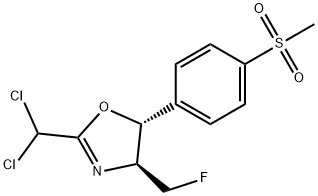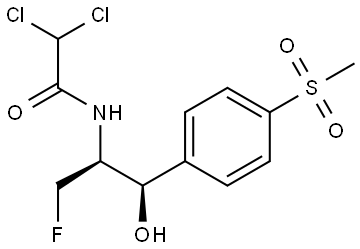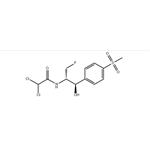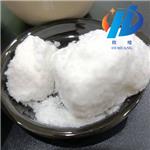Florfenicol
- CAS No.
- 73231-34-2
- Chemical Name:
- Florfenicol
- Synonyms
- 2,2-dichloro-n-[(1r,2s)-3-fluoro-1-hydroxy-1-(4-methylsulfonylphenyl)propan-2-yl]acetamide;NUFLOR;FLUPROFEN;30% water-soluble Florfenicol;4-(2-((dichloroacetyl)amino)-3-fluoro-1-hydroxypropyl)-benzenesulfonicaci;2,2-dichloro-n-(1-(fluoromethyl)-2-hydroxy-2-(4-(methylsulfonyl)phenyl)ethyl;[r-(r*, r*)]-n-[1-(fluoromethyl)-2-hydroxy-2-(4-(methylsulforyl)phenyl)-ethyl]-2,2-dichloroacetamide;AQUAFEN;Aquaflor;SCH-25298
- CBNumber:
- CB9195978
- Molecular Formula:
- C12H14Cl2FNO4S
- Molecular Weight:
- 358.21
- MDL Number:
- MFCD00864834
- MOL File:
- 73231-34-2.mol
- MSDS File:
- SDS
| Melting point | 153 °C |
|---|---|
| Boiling point | 618℃ |
| alpha | 26 +17.9° (DMF) |
| Density | 1.451±0.06 g/cm3(Predicted) |
| RTECS | DB6034000 |
| Flash point | >110°(230°F) |
| storage temp. | Inert atmosphere,2-8°C |
| solubility | Soluble in ethanol to 25mM and in DMSO to 100mM |
| form | solid |
| pka | 10.73±0.46(Predicted) |
| color | White to Off-White |
| Merck | 14,4109 |
| InChI | InChI=1S/C12H14Cl2FNO4S/c1-21(19,20)8-4-2-7(3-5-8)10(17)9(6-15)16-12(18)11(13)14/h2-5,9-11,17H,6H2,1H3,(H,16,18)/t9-,10-/m1/s1 |
| InChIKey | AYIRNRDRBQJXIF-NXEZZACHSA-N |
| SMILES | C(N[C@H](CF)[C@H](O)C1=CC=C(S(C)(=O)=O)C=C1)(=O)C(Cl)Cl |
| FDA 21 CFR | 556.283; 558.261; 558.4 |
| CAS DataBase Reference | 73231-34-2(CAS DataBase Reference) |
| FDA UNII | 9J97307Y1H |
| EPA Substance Registry System | Florfenicol (73231-34-2) |
SAFETY
Risk and Safety Statements
| Symbol(GHS) |   GHS08,GHS09 |
|||||||||
|---|---|---|---|---|---|---|---|---|---|---|
| Signal word | Danger | |||||||||
| Hazard statements | H410-H400-H361-H372 | |||||||||
| Precautionary statements | P201-P202-P281-P308+P313-P405-P501-P273-P391-P501-P273-P391-P501-P260-P264-P270-P314-P501 | |||||||||
| Hazard Codes | Xi | |||||||||
| Risk Statements | 36/37/38 | |||||||||
| Safety Statements | 26-36 | |||||||||
| WGK Germany | 3 | |||||||||
| HS Code | 29419090 | |||||||||
| NFPA 704 |
|
Florfenicol price More Price(37)
| Manufacturer | Product number | Product description | CAS number | Packaging | Price | Updated | Buy |
|---|---|---|---|---|---|---|---|
| Sigma-Aldrich | F1427 | Florfenicol analytical standard, for drug analysis | 73231-34-2 | 500mg | $210 | 2024-03-01 | Buy |
| TCI Chemical | F0811 | Florfenicol >98.0%(HPLC)(N) | 73231-34-2 | 1g | $138 | 2024-03-01 | Buy |
| TCI Chemical | F0811 | Florfenicol >98.0%(HPLC)(N) | 73231-34-2 | 5g | $422 | 2024-03-01 | Buy |
| Alfa Aesar | J66995 | Florfenicol, 98% | 73231-34-2 | 1g | $159 | 2024-03-01 | Buy |
| Alfa Aesar | J66995 | Florfenicol, 98% | 73231-34-2 | 5g | $532 | 2024-03-01 | Buy |
Florfenicol Chemical Properties,Uses,Production
Veterinary antibiotics
Florfenicol is currently a commonly used veterinary antibiotic with a broad antibacterial spectrum and a strong antibacterial effect as well as a low the minimum inhibitory concentration (MIC). The antibacterial of florfenicol is about 15-20 times as high as that of chloramphenicol and the thiamphenicol. After administration through feed for 60 minutes, the drug concentration in the tissue can reach peak which can quickly control the disease with having characteristics such as being safe, non-toxic, no residue, and no risk for triggering aplastic anemia. Therefore, it is quite suitable for large-scale farms application. It is mainly used for the treatment of bovine respiratory disease caused by Pasteurella and Haemophilus. It has good efficacy in treating the cattle footrot disease cause by Fusobacterium, and can be also used for treating the infection diseases of pigs and chickens caused by sensitive strains as well as the bacterial disease of fish.
It is not easy for bacteria to evolve resistance against florfenicol: Because it has a fluorine atom which replaces the hydroxyl group on the molecular structure of thiamphenicol, thus effectively solving the drug resistant issue of chloramphenicol, and thiamphenicol. Bacteria which are resistant to thiamphenicol, chloramphenicol, amoxicillin, and quinolone remain sensitive to the chemicals.
Since chloramphenicol can result in severe adverse reactions such as aplastic anemia and immune suppression, it is banned from being applied in food animal production. Studies have demonstrated that: the major group in the chemical structure of chloramphenicol which causes aplastic anemia is para-nitro in the aromatic ring. Instead, florfenicol has the CH3SO4 which replaces the NO2 groups so that its chemical structure has been changed. In this case, its application to animal will not cause any adverse reactions such as aplastic anemia. Therefore, it is approved for application in more than a dozen of countries such as Japan, Mexico and China. Florfenicol is characterized by: a broad spectrum antibiotic; Salmonella, Escherichia coli, Proteus, Haemophilus, Actinobacillus pleuropneumoniae, Mycoplasma hyopneumoniae, Streptococcus Suis, swine Pasteurella, Bordetclla bronchiseptica, and Staphylococcus aureus are all sensitive to it. The drug is easy for absorbing and is widely distributed in the body and is quick-acting and long-acting formulations with no potential risk of causing aplastic anemia risks and thus having a better security. In addition, it has an affordable price which is cheaper than other drugs for prevention and treatment of respiratory diseases such as tiamulin, tilmicosin, and azithromycin. The cost of medication is easy for users to accept. Because of all these excellent characteristics, domestic florfenicol is widely applied and has currently become the first-choice drug for prevention and treatment of livestock respiratory diseases and gastrointestinal bacterial infection diseases.
Florfenicol is not suitable to be applied in combination with quinolones, penicillins, and cephalosporins, and it has no compatibility with ampicillin, sulfonamides, and furans.
The above information is edited by the Chemicalbook of Dai Xiongfeng.
Pharmacological effects
Florfenicol binds tightly with the 50S subunit of the bacterial ribosome and block the transpeptidation reaction mediated by peptidyl transferase, and thereby suppressing the elongation process of the peptide chain; meanwhile selectively acts on the bacterial 70S ribosome receptors and changes, interferes with the function of peptidyl transferase enzyme. Therefore, it interferes with the bacterial protein synthesis based on dual mechanism.
Indications
Florfenicol can strongly interfere with the bacterial protein synthesis. It has a rapid absorption rate and is widely distributed in the body; it has long half-life without side effects such as aplastic anemia; not easy for bacteria to evolve drug resistance, and has no cross-resistance.
Florfenicol can be used for the treatment of the systemic infection of livestock and aquatic animals, and has significant efficacy on treating respiratory infections and intestinal infections.
Poultry: Escherichia coli disease, salmonellosis, infectious rhinitis, chronic respiratory disease, duck plague and other kinds of mixed infections caused by susceptible strains.
Animals: Mixed infections such as infectious pleurisy, asthma, streptococcal disease, Escherichia coli disease, salmonellosis, contagious pleuropneumonia, enzootic pneumonia, paratyphoid piglets yellow white diarrhea, edema disease, atrophic rhinitis, lung epidemic, red white diarrhea piglets, and agalactia syndrome occurred in animals such as pigs, cows, and sheep.
Crab: appendages ulcer disease, yellow gills, rotten gill, red legs and red fluorescent body inflammatory disease syndrome.
Turtle: red neck disease, furunculosis, shot-hole disease, skin fester disease, inflammatory bowel disease, mumps, and bacterial sepsis.
Frogs: cataract syndrome, ascites disease, sepsis, enteritis.
Fish: enteritis disease, ascites disease, vibriosis, Edward coli disease.
Eel: debonding septicemia (unique effect), Edward coli disease, red skin disease, inflammatory bowel disease.
Uses
It is a kind of antibacterial drug. It is used as the veterinary antimicrobial drugs for treating bacterial diseases of pigs, chickens and fish. It has good efficacy in treating the infection disease of pigs, chickens and fish induced by sensitive bacteria, especially for treating respiratory infections and intestinal infections.
Description
Florfenicol is a broad-spectrum fluorinated antibiotic and a derivative of thiamphenicol . It is active against human clinical isolates of enteric bacteria, including E. coli, Klebsiella, Enterobacter, Citrobacter, P. mirabilis, and Salmonella (MIC50s = 6.3-12.5 μg/ml). Florfenicol is also active against clinical isolates of various bovine and porcine respiratory tract pathogens, including P. multocida, A. pleuropneumoniae, and B. bronchiseptica (MIC50s = 0.25-4 μg/ml). It inhibits peptidyl transferase activity in 70S ribosomes isolated from E. coli when used at a concentration of 1 mM. Formulations containing florfenicol have been used in the treatment of infectious respiratory disease in cattle.
Chemical Properties
White or off-white crystalline powder, odorless. Easily soluble in dimethylformamide, soluble in methanol, slightly soluble in glacial acetic acid, very slightly soluble in water or chloroform.
Uses
Florfenicol is a fluorinated derivative of thiamphenicol. It is a protein synthesis inhibitor that inhibits bacterial protein synthesis by binding to ribosome 50S and 70S subunits. Florfenicol is used as an antibacterial.
Preparation
Florfenicol is synthesised from thiamphenicol by replacing the 3-hydroxy group with fluorine, first synthesised at Schering in 1980. By replacing the hydroxy group, it was rationalised that chloramphenicol resistance via chloramphenicol acetyltransferase could be eliminated. Florfenicol is a broad spectrum antibiotic with good activity against Gram negative and anaerobic bacteria. It acts by binding to the 23S sub-unit of the 50S ribosome, inhibiting protein synthesis. Florfenicol has been extensively studied with over 400 literature citations.
Definition
ChEBI: Florfenicol is a carboxamide that is the N-dichloroacetyl derivative of (1R,2S)-2-amino-3-fluoro-1-[4-(methanesulfonyl)phenyl]propan-1-ol. A synthetic veterinary antibiotic that is used for treatment of bovine respiratory disease and foot rot; also used in aquaculture. It has a role as an antimicrobial agent. It is a sulfone, a secondary alcohol, an organofluorine compound, an organochlorine compound and a secondary carboxamide. It is functionally related to a dichloroacetic acid.
Veterinary Drugs and Treatments
The drug is approved for use in cattle only (in the USA) for the
treatment of bovine respiratory disease (BRD) associated with
Pasteurella haemolytica, Pasteurella multocida, and Haemophilus
somnus.
Because florfenicol has activity against a wide range of microorganisms
(e.g., Mycoplasma), it may be useful for treating other
infections in cattle (or other species) as well, but specific data is
limited.


Florfenicol Preparation Products And Raw materials
Raw materials
1of2
Preparation Products
| Supplier | Tel | Country | ProdList | Advantage | |
|---|---|---|---|---|---|
| Masteam Bio-tech Co., Ltd. | +86-15200345168 +86-15200345168 | bruce.lei@masteam.com | CHINA | 153 | 58 |
| Wuhan Fortuna Chemical Co., Ltd | +86-27-59207850 +86-13986145403 | info@fortunachem.com | China | 5988 | 58 |
| Hebei ZB Gamay Biological Technology Co.,Ltd | +86-031189171450 +86-15632359451 | chem@zbvet.net | China | 222 | 58 |
| Hebei Mojin Biotechnology Co., Ltd | +8613288715578 | sales@hbmojin.com | China | 12456 | 58 |
| Henan Suikang Pharmaceutical Co.,Ltd. | +8618239973690 | sales@suikangpharm.com | China | 178 | 58 |
| Shaanxi TNJONE Pharmaceutical Co., Ltd | +8618740459177 | sarah@tnjone.com | China | 893 | 58 |
| XI'AN TIANGUANGYUAN BIOTECH CO., LTD. | +86-029-86333380 18829239519 | sales06@tgybio.com | China | 959 | 58 |
| shandong perfect biotechnology co.ltd | +86-53169958659; +8618596095638 | sales@sdperfect.com | China | 294 | 58 |
| Shaanxi Haibo Biotechnology Co., Ltd | +undefined18602966907 | qinhe02@xaltbio.com | China | 1000 | 58 |
| Anhui Ruihan Technology Co., Ltd | +8617756083858 | daisy@anhuiruihan.com | China | 994 | 58 |
Related articles
- Description, Bioactivity and Application of Florfenicol
- Flubenicol sodium succinate is a white or white crystalline powder, odorless and tasteless, easy to deliquescence when the air....
- Jul 11,2022
View Lastest Price from Florfenicol manufacturers
| Image | Update time | Product | Price | Min. Order | Purity | Supply Ability | Manufacturer | |
|---|---|---|---|---|---|---|---|---|
![2,2-Dichloro-N-[(1R,2S)-3-fluoro-1-hydroxy-1-(4-methylsulfonylphenyl)propan-2-yl]acetamide pictures](/ProductImageEN/2024-04/Small/ab5da5a3-d28d-4a20-88bd-f000161cfec0.png) |
2024-04-25 | 2,2-Dichloro-N-[(1R,2S)-3-fluoro-1-hydroxy-1-(4-methylsulfonylphenyl)propan-2-yl]acetamide
73231-34-2
|
US $6.00 / KG | 1KG | More than 99% | 2000KG/Month | Hebei Saisier Technology Co., LTD | |
 |
2024-04-25 | Florfenicol
73231-34-2
|
US $0.00 / kg | 25kg | ≥98% | 10tons | Henan Suikang Pharmaceutical Co.,Ltd. | |
 |
2024-04-24 | Florfenicol
73231-34-2
|
US $15.00 / kg | 1kg | 99.912% | 10ton | Ouhuang Engineering Materials (Hubei) Co., Ltd |
-
![2,2-Dichloro-N-[(1R,2S)-3-fluoro-1-hydroxy-1-(4-methylsulfonylphenyl)propan-2-yl]acetamide pictures](/ProductImageEN/2024-04/Small/ab5da5a3-d28d-4a20-88bd-f000161cfec0.png)
- 2,2-Dichloro-N-[(1R,2S)-3-fluoro-1-hydroxy-1-(4-methylsulfonylphenyl)propan-2-yl]acetamide
73231-34-2
- US $6.00 / KG
- More than 99%
- Hebei Saisier Technology Co., LTD
-

- Florfenicol
73231-34-2
- US $0.00 / kg
- ≥98%
- Henan Suikang Pharmaceutical Co.,Ltd.
-

- Florfenicol
73231-34-2
- US $15.00 / kg
- 99.912%
- Ouhuang Engineering Materials (Hubei) Co., Ltd
73231-34-2(Florfenicol)Related Search:
1of4





